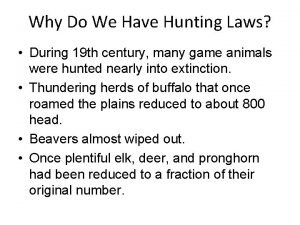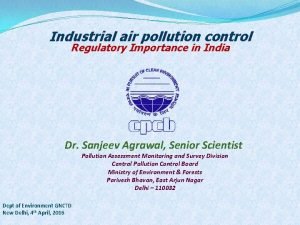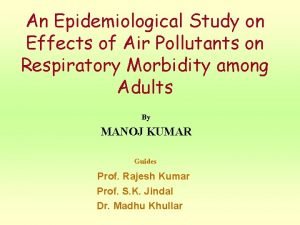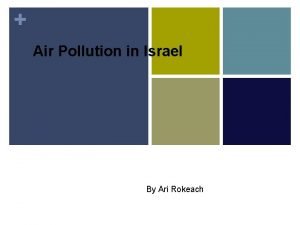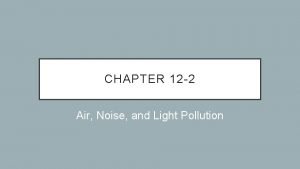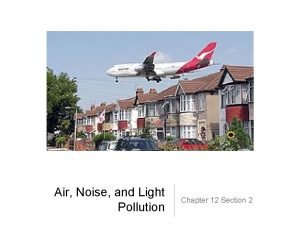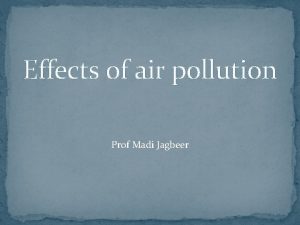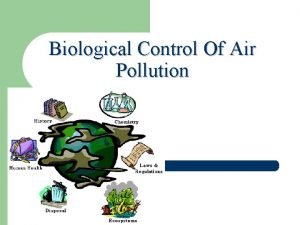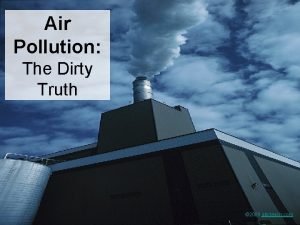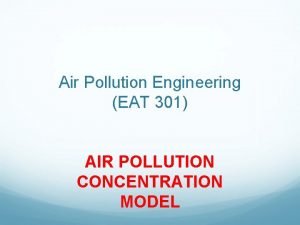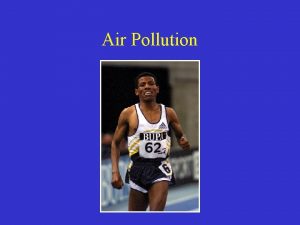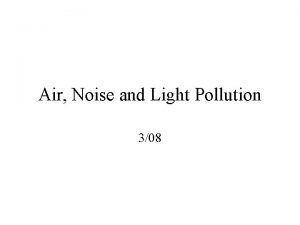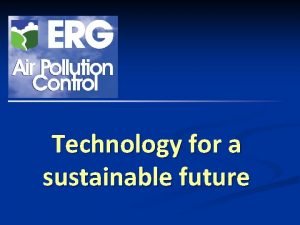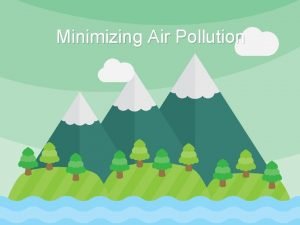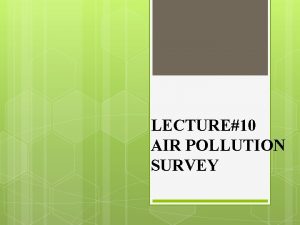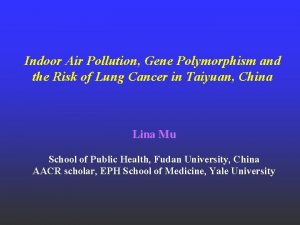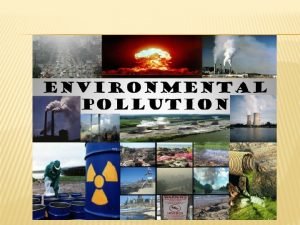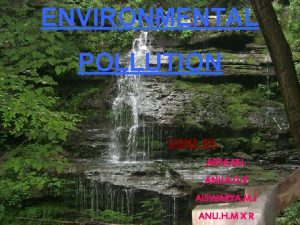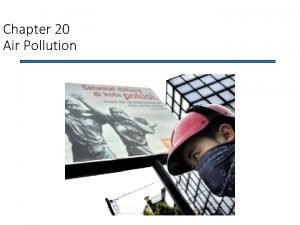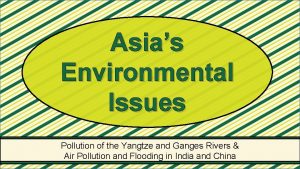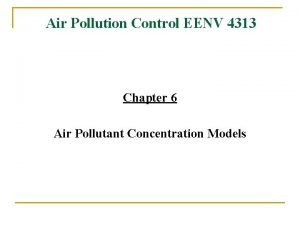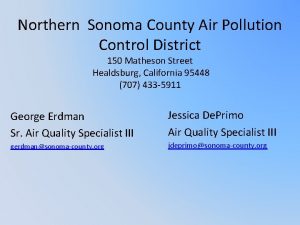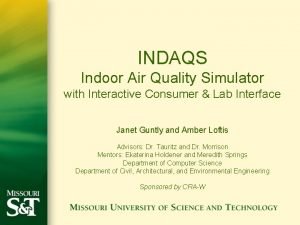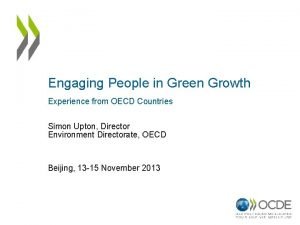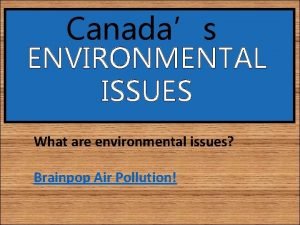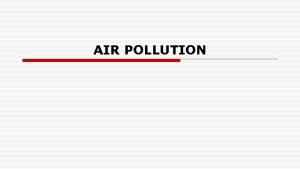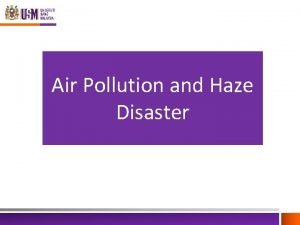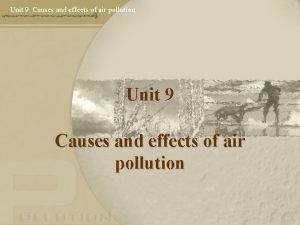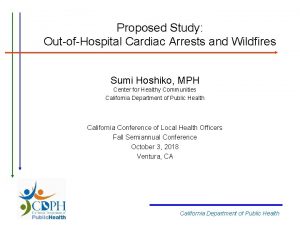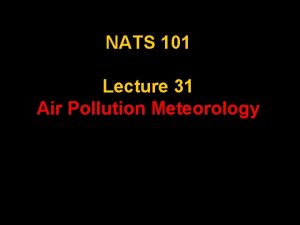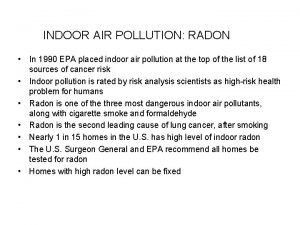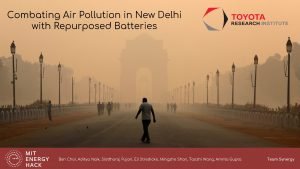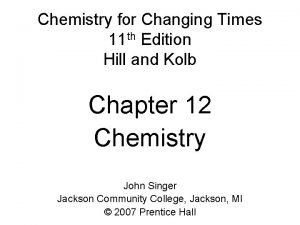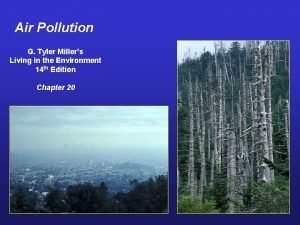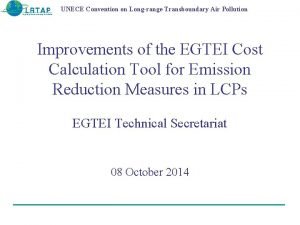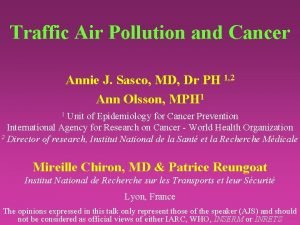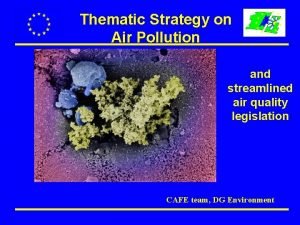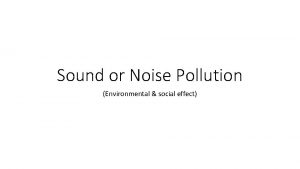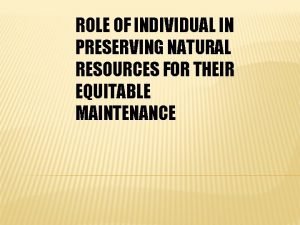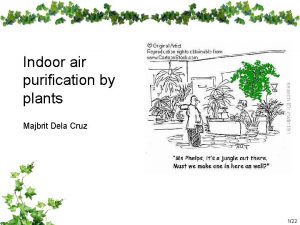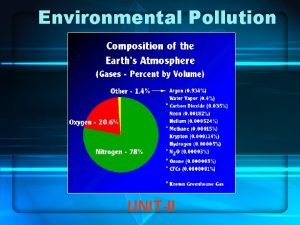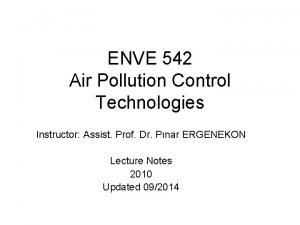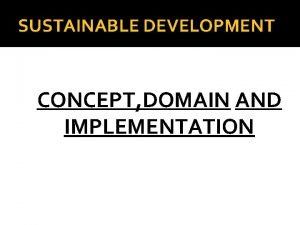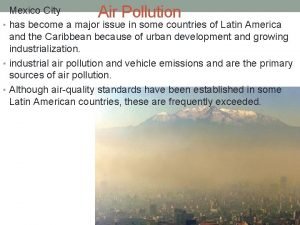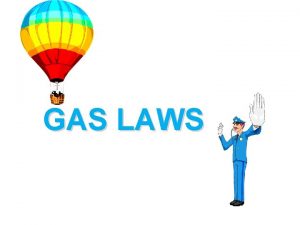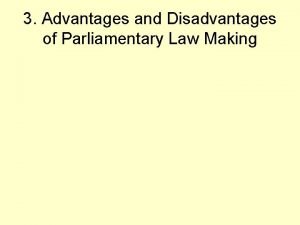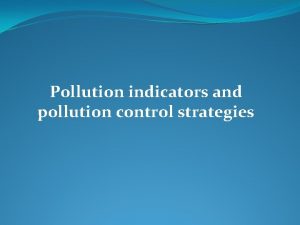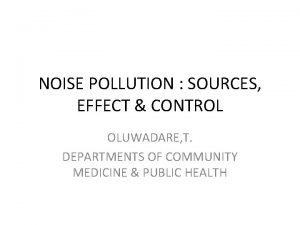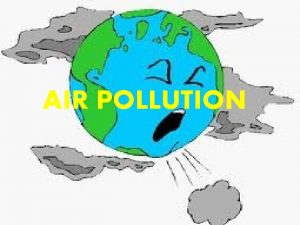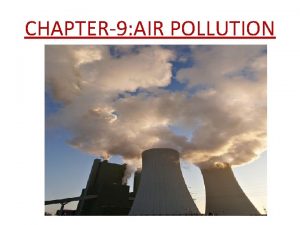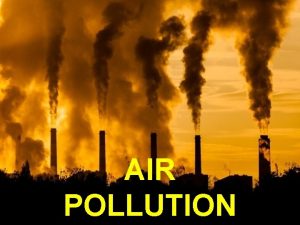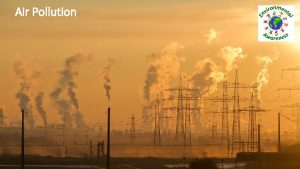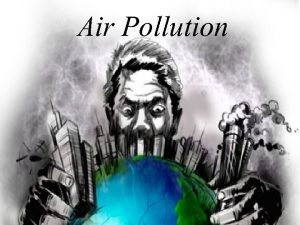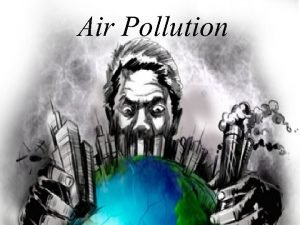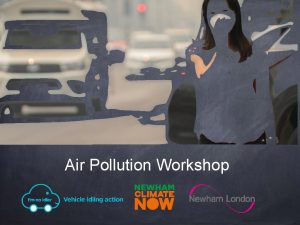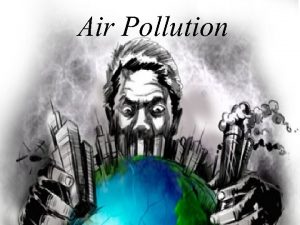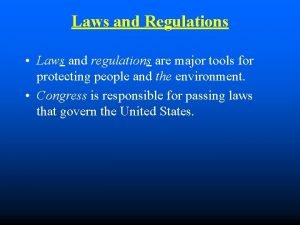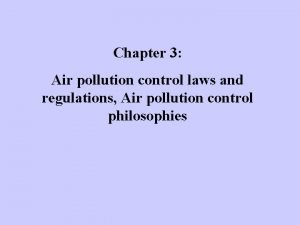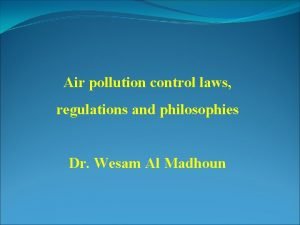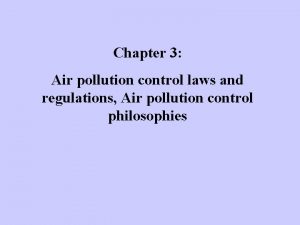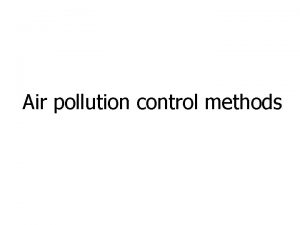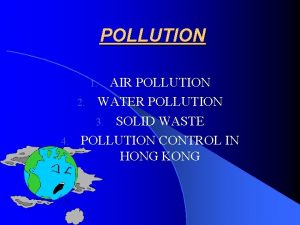Introduction of Air pollution laws and regulations in











![Monitoring Results; VOCs 2008 [2007] Monitoring Exceeding points Average Standards Benzene Trichloroethylene Tetrachloroethylene Dichloromethane Monitoring Results; VOCs 2008 [2007] Monitoring Exceeding points Average Standards Benzene Trichloroethylene Tetrachloroethylene Dichloromethane](https://slidetodoc.com/presentation_image_h2/7ee5f03ace5de4510c7c060d200290ba/image-12.jpg)























































- Slides: 67

Introduction of Air pollution laws and regulations in Japan Oct, 2011 JICA (JEMAI) Kenzo OOKA 1

They recognized that it is very difficult to attain the air quality standard only by regulating each emission source and ‘the governor of the prefecture shall prescribe the total mass emission control standard’. Photos (Right 1950 s) : Copyright 2010 City of Yokkaichi, Mie, Japan 2

SO 2 generated from non-auto & auto (1970 -2008) Orange: Road monitoring stations, Green: General monitoring stations 3

Achievement rate of the environmental standards (SO 2), 2000 -2009 Grey: Road monitoring stations, White: General monitoring stations 4

NO 2 generated from non-auto & auto (1970 -2008) Orange: Road monitoring stations, Green: General monitoring stations 5

NO 2 generated from non-auto & auto (2004 -2008) Blue: Satisfied the NO 2 standard, Green: the number of monitoring stations 6

SPM generated from non-auto & auto (2004 -2008) Blue: Satisfied the SPM standard, Green: the number of monitoring stations 7

SPM generated from non-auto & auto (1970 -2008) Orange: Road monitoring stations, Green: Other monitoring stations 8

A rate of Children’s Asthma 1980 – 2008 (Ministry of Education) Primary school Junior high school Kindergarten High school 9

Ambient Fine Particles; PM 2. 5: very small and potential surface adsorption http: //www. env. go. jp/air/info/mpmhea_kentou/01/ref 01. pdf 10

Monitoring Stations • 1, 987 monitoring points (measuring stations) – Monitoring stations of 1549 (general) and 438 (road-side monitoring points) • The achievement rate of the SO 2 environmental standards; 99. 6 %(G 1, 125), 100% (R 68 ) – NO 2 and SPM is well controlled as shown above • However, the achievement rate of the environmental standards (photochemical oxidant) was nearly zero – VOCs and other chemicals 11
![Monitoring Results VOCs 2008 2007 Monitoring Exceeding points Average Standards Benzene Trichloroethylene Tetrachloroethylene Dichloromethane Monitoring Results; VOCs 2008 [2007] Monitoring Exceeding points Average Standards Benzene Trichloroethylene Tetrachloroethylene Dichloromethane](https://slidetodoc.com/presentation_image_h2/7ee5f03ace5de4510c7c060d200290ba/image-12.jpg)
Monitoring Results; VOCs 2008 [2007] Monitoring Exceeding points Average Standards Benzene Trichloroethylene Tetrachloroethylene Dichloromethane 12

PRTR means ‘Pollutant Release and Transfer Register’ PRTRs are inventories of pollution from industrial sites and other sources Concerned chemicals regulated Unregulated one New regulations PRTR Total inventories of pollutant PRTRs are basically tools for planning management to reduce risks to the environment from potentially harmful chemical substances. All sectors of society can participate in environmental risk reduction And may find cost-effective countermeasures 13

PRTR • PRTR has selected 562 substances from a range of chemical substances suspected of affecting human health and the environment. – 24 business classes including medical facilities • They were chosen by ranking substances according to the level of hazard, volume of domestic production, and level of exposure resulting from their use. – Degrees of toxicity and size of the company using these substances – Ex. carcinogenic substances and endocrine disruptive effects etc. • It is necessary to review these selections every year as new scientific knowledge sheds light on the toxicity of substances. 14

PRTR • PRTR(Pollutant Release and Transfer Register) system is to promote voluntary improvement of the management of chemical substances by business operators • To prevent any impediments to the preservation of the environment by taking measures for the confirmation of release amounts, etc. of specific chemical substances in the environment by business operators http: //www 2. env. go. jp/chemi/prtrinfo/e-index. html Please visit and see: http: //www. prtr. nite. go. jp/english/prlaw-e. html 15

PRTR (2009) http: //www. env. go. jp/en/chemi/prtr. html 16

Substance to substance volume changes of emission to air (comparison between 2001 and 2005 in terms of the top 5 substances) National Institute of Technology and Evaluation (NITE), August 2007 Source: NITE 17

Toluene • Major industrial sectors that emitted toluene to air in 2005 included, in descending order: Plastic products (21, 000 tons, 20% of all industries), Transportation equipment (17, 000 tons, 16%), Publishing, printing and allied industries (13, 000 tons, 13%), Pulp, paper and paper products(11, 000 tons, 10%). • Air emission of toluene showed a decrease of 27, 000 tons (20%) over the 2001 -2005 period. • Some industries, on the other hand, increased air emissions of toluene over these five years: • these included, in descending order, General machinery (1, 200 tons (51%)), Plastic products (730 tons (3. 7%)) and Automobile maintenance services (290 tons (460%)). Source: NITE 18

Xylene • Major industrial sectors that emitted xylene to air in 2005 included, in decreasing order: • Transportation equipment (21, 000 tons, 47% of all industries), General machinery (5, 200 tons, 12%), and Fabricated metal products (4, 400 tons, 10%). • Overall air emission of xylene decreased by 7, 500 tons (14%) over the 2001 -2005 period. • Some industries, on the other hand, increased air emissions of xylene over these five years: • these included General machinery (990 tons (23%)), Electrical machinery, equipment and supplies (320 tons (17%)), and Rubber products (310 tons (37%)). Source: NITE 19

Methylene dichloride • Major industrial sectors that emitted methylene dichloride to air in 2005 included, in descending order: Fabricated metal products (3, 500 tons, 16% of all industries), Chemical and allied products (3, 500 tons (16%)), and Transportation equipment (2, 600 tons (12%)). • Overall air emission of methylene chloride showed a decrease of 5, 100 tons (19%) over the 2001 -2005 period. • Some industries, on the other hand, increased air emissions of methylene chloride over these five years: these included, in descending order, Lumber and wood products (820 tons (57%)), Miscellaneous manufacturing industries (330 tons (24%)), and Non-ferrous metals and products (130 tons (13%)). Source: NITE 20

Ethyl Benzene Major industrial sectors that emitted ethyl benzene to air in 2005 included, in descending order: Transportation equipment (8, 600 tons, 57% of all industries), General machinery (1, 400 tons, 9. 7%), and Fabricated metal products (1, 300 tons, 8. 8%). Overall emission of ethyl benzene to air grew steadily over the 2001 to 2005 period (5, 700 tons, 63%), and major contributions came from, in descending order, Transportation equipment (3, 300 tons (64%)), General machinery (800 tons (130%)) and Fabricated metal products (590 tons (82%)). Emission of ethyl benzene increased in many industrial sectors during the five years with some sectors showing decreased emission. Publishing, printing and allied industries (-88 tons (-56%)) were a typical example of this. “Chemical Substances with a Large Increase/decrease of Air Emission”, one of the key factors contributing to the increased emission of ethylbenzene was the fact that facilities became increasingly aware of the distinction between ethylbenzene and xylene (a sizable proportion of ethylbenzene had previously been reported as xylene because it is an important ingredient of mixed xylene). A substantial proportion of mixed xylene is used in paint solvents and those industrial sectors that reported significantly increased amounts of ethylbenzene (Transportation equipment, General machinery, Fabricated metal products) use a lot of this material as a solvent. Source: NITE 21

PRTR Air Emission (2003 -2008, unit: ton) 22

Air Pollution Control Act 23

Outline of the Article 1 (Purpose) • The purposes of the Law – To protect the public health and preserve the living environment with respect to air pollution, • by controlling emissions of soot, smoke and particulate from the business activities of factories and business establishments; • by promoting various measures concerning hazardous air pollutants; and, by setting maximum permissible limits for automobile exhaust gases, etc. 24

Article 1 (Purpose) Where? Business activities (factories etc. ) While buildings are being demolished Automobile exhaust gases What? Soot, smoke and particulate VOCs Demolition particulate How? 1. Controlling emissions 2. Promoting various measures concerning hazardous air pollutants 3. Setting maximum permissible limits for automobile exhaust gases Help victims of air pollution-related health damage by providing a liability regime health damage caused by air pollution from business activities. 25

Article 1 (Purpose) • The purposes of this Law are as follows. – One is to protect the public health and preserve the living environment with respect to air pollution, by controlling emissions of soot, smoke, particulate and VOCs from the business activities of factories and business establishments; by controlling emissions of particulate while buildings are being demolished; by promoting various measures concerning hazardous air pollutants; and, by setting maximum permissible limits for automobile exhaust gases, etc. – The other is to help victims of air pollution-related health damage by providing a liability regime health damage caused by air pollution from business activities. 26

Article 2 (Definitions) • (2 -1) In this Law, the term "soot and smoke" means the substances enumerated below: – Sulfur oxides generated as a result of combustion of fuel and the like; – Soot and dust generated as a result of combustion of fuel and the like, or of the use of electricity as a heat-source; and, – Cadmium, chlorine, hydrogen fluoride, lead and other substances (excluding those enumerated in Item 1 hereof) which are generated as a result of combustion, synthesis, resolution and other treatments (excluding mechanical treatments) and which are designated by Cabinet Order as those which are liable to adversely affect human health or the living environment. 27

Article 2 (Definitions) • (2 -9) the term "designated particulate" means asbestos and other substances designated by Cabinet Order as those which are liable to adversely affect human health, and the term "general particulate" means particulate other than designated particulate. – "designated particulate discharging activity" means any activity which demolishes, remodels or renovates a building where materials which are designated by Cabinet Order as those which contain designated particulate are used. (2 -12) 28

Article 2 (Definitions) • (2 -13) In this Law, the term "hazardous air pollutants" means air pollutants which are liable to adversely affect human health through longterm exposure, other than soot and smoke and designated particulate. • (2 -14) In this Law, "exhaust gases from motor vehicles" means carbon monoxide, hydrocarbons, lead and other substances exhausted during the operation of those motor vehicles which are designated by Order of the Prime Minister's Office. 29

Chapter II : REGULATION OF SOOT AND SMOKE EMISSION • Article 3 (Emission Standards) – The emission standards mean the maximum permissible limits for: (1) Item 1 Sulfur oxides (2) Item 2 Soot and dust (3) Item 3 Toxic substances 30

Article 3 (Emission Standards) • Maximum permissible limits on the amounts of sulfur oxides which are generated in a soot and smoke emitting facility and emitted into the air from an outlet of the facility are prescribed for each of the areas designated by Cabinet Order in accordance with the height of the outlet (hereinafter will refer to the height adjusted in accordance with the procedure stipulated by Order of the Prime Minister's Office). 31

Article 3 (Emission Standards) – Maximum permissible limits on the amount of soot and dust contained in the materials generated in a soot and dust emitting facility and emitted into the air from an outlet are prescribed for each kind and scale of facility. – Maximum permissible limits on the amounts of toxic substances contained in the materials generated in a soot and smoke emitting facility and emitted into the air from an outlet are prescribed for each kind of toxic substance and facility. 32

Article 3 (Emission Standards) • Maximum permissible limits on the amount of specific toxic substances designated by the Director General of the Environment Agency from among toxic substances generated in a soot and smoke emitting facility as a result of combustion of fuel and the like and emitted into the air, ("specific toxic substances") are prescribed for each kind of the specific toxic substance in accordance with the height of the outlet. 33

Article 3 (Emission Standards) • (3 -5) In cases where the Prime Minister establishes an emission standard with respect to sulfur oxides under the provisions, he shall hear the opinions of the governor of the prefecture (hereinafter including Tokyo, Osaka, Kyoto etc. ) concerned. – The same shall apply in case of amendment or abolition of such a standard. 34

Article 4 • In case any prefecture recognizes that the existing emission standards with respect to soot and dust and toxic substances are inadequate to protect public health or conserve the natural and social conditions of the living environment in a part of its area, it may establish by a prefectural ordinance in accordance with the provisions of Cabinet Order, stricter emission standard with respect to such pollutants generated by soot and smoke emitting facilities in the part of the area which supersedes the maximum permissible limits under the provision of Paragraph 1 of the preceding article. 35

Article 5 -2 (Total Mass Emission control Standards) • In areas where factories and industrial establishments are concentrated and designated by Cabinet Order as areas in which it is recognized to be difficult to attain the standard ("air quality standard") prescribed as the environmental condition relating to ambient air solely with the emission standards relating to sulfur oxides and other soot and smoke, the governor of the prefecture shall formulate a designated soot and smoke total mass reduction plan relating to the designated soot and smoke generated at the soot and smoke emitting facilities in the designated area that are above the size prescribed by the governor of the prefecture in conformity with the standard prescribed by Order of the Prime Minister's Office ("specific factories, etc. "), and the governor of the prefecture shall prescribe on the basis of such plan the total mass emission control standard as provided by Order of the Prime Minister's Office. 36

Article 6 (Notification of the Establishment of a Soot and Smoke Emitting Facility) • Any person who plans to establish a soot and smoke emitting facility shall notify the following information to the governor of the prefecture: – The name of the firm and address, or the representative name of the legal person; – Name and location of the plant or business establishment; – Kind of proposed soot and smoke emitting facility; – Structure of the proposed soot and smoke emitting facility; – Method of operation of the proposed soot and smoke emitting facility; and, – Proposed method of disposal of the soot and smoke. 37

Article 8 (Report of Changes in the Construction of Soot and Smoke Emitting Facilities) • In case any person who notifies under the provisions of Paragraph 1 Article 6 or Paragraph 1 of the preceding article plans to change any of the matters listed under Items 4 through 6 of Paragraph 1, Article 6, he shall notify the change to the governor of the prefecture in accordance with the provisions of Order of the Prime Minister's Office. 38

Article 9 (Order for Modification of Proposed Plan, etc. ) • In cases where the governor of the prefecture finds that the estimated volume of soot and smoke or the estimated density of soot and smoke which will be generated and emitted by the soot and smoke emitting facility notified under the provisions of the preceding article fails to meet the emission standard he may order, within 60 days after the receipt of notification, the notifying person to modify the Plan relating to the structure, the method of operation or the method of soot and smoke disposal of the proposed soot and smoke emitting facility (including abolition of the plan notified under the provisions of Paragraph 1 of the preceding article) or to eliminate the plan for the installation of the proposed soot and smoke emitting facility notified under the provision of Paragraph 1 of Article 6. 39

Article 9-1 (Order for Modification of Proposed Plan, etc. ) • In cases where the governor of the prefecture finds that the total volume of soot and smoke which will be generated and emitted by all the soot and smoke emitting facilities at specific factories, etc. notified under the provisions of Paragraph 1 of Article 6 etc. fails to meet a total mass emission control standard, the governor may order within 60 days after the receipt of notification the persons who established said specific factory, etc. , to improve the method of disposal of the designated soot and smoke, to change the fuel used, or to take any other measures as may be necessary. 40

Article 10 (Restriction on the Implementation of Plans) • Any person who provided notification under the provisions of Article 6 or Article 8 shall not install the notified soot and smoke emitting facility or change the structure, the method of operation or the method of disposal of soot and smoke of the notified soot and smoke emitting facility within 60 days after notification is received. 41

Article 13 (Restrictions on the Emission of Soot and Smoke) • No person who emits soot and smoke generated by a soot and smoke emitting facility shall emit soot and smoke the volume or density of which fails to meet the emission standards at the outlet of the facility. – The provisions of the preceding paragraph shall not apply to soot and smoke generated by and emitted into the air from a facility of a person for 6 months (or l year in the case of a facility designated by Cabinet Order) after the facility is designated as a soot and smoke emitting facility. – However, it shall apply when an ordinance of the local public entity applicable to the person prescribes such provisions corresponding to the preceding paragraph (it shall not apply if related penal provisions are not Prescribed in the ordinance of the local public entity. ) 42

Article 13 -2 (Restrictions on the Emission of Soot and Smoke) • No soot and smoke emitting facility emitting soot and smoke at a specific factory, etc. , may emit soot and smoke which fails to meet the total mass emission control standard in terms of the total volume emitted at the outlets of all the soot and smoke emitting facilities at said specific factories, etc. , into the ambient air. – In cases where a factory or business establishment is newly designated as a specific factory, etc. , due to a revision of Cabinet Order referred to in Paragraph 2 of Article 2, amendment of a Cabinet Order which designated the areas as provided for in Paragraph 1 of Article 5 -2, or change in the size prescribed by the governor of the prefecture as provided for in the same paragraph, the provisions of the preceding paragraph shall not apply for 6 months from the date on which the said factory or business establishment became so designated. 43

Article 14 (Order for Improvement, etc. ) • 1. In cases where the governor of the prefecture recognizes that a soot and smoke emitting person is likely to continuously emit soot and smoke whose volume or density fails to meet the emission standards at the outlet and that continued emission of such soot and smoke [may cause damage to human health or the living environment], he may order the person to improve, within a prescribed period, the structure, the method of operation, or the method of disposal of soot and smoke generated by the soot and smoke emitting facility, or to suspend the operation of the facility temporarily. (Blue part was deleted in FY 2010) 44

Article 14 (Order for Improvement, etc. ) • 3. In cases where soot and smoke are likely to be continuously emitted and fail to meet noncompliance with the total mass emission control standard and when the governor of the prefecture recognizes that continued emission may cause damage to human health or the living environment, he may order the person who established the specific factory, etc. , relating to said designated soot and smoke to improve, within a prescribed period, the method of soot and smoke disposal at the specific factory, etc. , to change the fuel used, or to take such other measures as may be necessary. (Blue part was deleted in FY 2010) 45

Article 16 (Measuring the Volume of Soot and Smoke, etc. ) • Any soot and smoke emitting person shall measure and keep record of the volume and density of the soot and smoke generated by his soot and smoke emitting facility under Order of the Prime Minister's Office. [Omission or neglect to comply with: fine up to 300, 000 yen] 46

Article 14 (Order for Improvement, etc. ) • 4. In cases where a factory or business establishment was newly designated as a specific factory, etc. , the provisions of the preceding paragraph shall not apply for 6 months from the day on which the said factory or business establishment became so designated. 47

Article 17 (Measures in case of an accident) • Any person who has installed a soot and smoke emitting facility or any person who has installed a facility (excluding a soot and smoke emitting facility; "specific facility" ) which, in the process of synthesis, resolution, or other chemical treatment of substances, generates air pollutants designated by Cabinet Order as those which are liable to adversely affect human health or the living environment ("specific substances") shall take emergency measures immediately and try to take restoration measures soon after an accident occurs in a soot and smoke emitting facility or a specific facility which causes the discharge of soot and smoke or specific substances in a large quantity into the air. • Shall notify the prefectural governor of the situation of the accident as soon as possible 48

Article 17 -3 ~ 17 -15 (Measures regarding VOCs control) • • • Outline Emission Standards Notification of the Establishment of a VOCs Emitting Facility Report of Changes in the Construction of a VOCs Emitting Facility Order for Modification of Proposed Plan, etc. Restriction on the Implementation of Plans Restrictions on the Emission of VOCs Order for Improvement, etc. Measuring the concentration of VOCs etc. 49

Chapter II : 2. REGULATION CONCERNING PARTICULATES Article 18 (Notification of the installing of General Particulate Discharging Facility) • Any person who plans to establish a general particulate discharging facility shall notify the following information to the governor of the prefecture in accordance with the provisions by Order of the Prime Minister's Office. 50

• Article 18 -3 (Obligation to Observe the Standard) • Any person who has installed a general particulate discharging facility or facilities shall observe the standards prescribed by Order of the Prime Minister's Office relating to the structure, operation and management of the general particulate discharging facility. 51

Article 18 -4 (Order to Conform to the Standards, etc. ) • In cases where the governor of the prefecture finds that any person who has installed a general particulate discharging facility fails to observe the standards referred to in the preceding article, the Governor may order that person to conform to the said standards with respect to the general particulate discharging facility within a certain prescribed period or order temporary suspension of operation of the facility. 52

THE BASIC ENVIRONMENT LAW (Law No. 91 of 1993. Effective on November 19, 1993) http: //home. hiroshimau. ac. jp/er/EL_KKe. html 53

Chapter 1 General Provisions • Article 1 (Purpose) The purpose of this law is to comprehensively and systematically promote policies for environmental conservation to ensure healthy and cultured living for both the present and future generations of the nation as well as to contribute to the welfare of mankind, through articulating the basic principles, clarifying the responsibilities of the State, local governments, corporations and citizens, and prescribing the basic policy considerations for environmental conservation. 54

Article 2 (Terminology) • 1 For the purpose of this law, "environmental load" means any adverse effects on the environment generated by human activities which may cause interference with environmental conservation. 2 For the purpose of this law, "global environmental conservation" means environmental conservation regarding such phenomena as global warming, the ozone layer depletion, marine pollution, decrease in wildlife species and others which are caused by human activities and affect the environment of the entire globe or a large part of it, which contributes to the welfare of mankind as well as to the healthy and cultured living of the people. 55

Article 2 (Terminology ) • 3 For the purpose of this law, "environmental pollution" ("Kogai") means, among interference with environmental conservation, air pollution, water pollution (including a deterioration of water's unadulterated state other than the water quality and the quality of the bottom. The same shall apply hereinafter except for Article 16 Paragraph 1. ), soil contamination, noise, vibration, ground subsidence, and offensive odors affecting an extensive area as a result of business and other human activities, which cause damage to human health or the living environment (including property closely related to human life, as well as fauna and flora closely related to human life and their living environment. The same shall apply hereinafter. ) 56

Article 7 (Responsibility of Local Governments) The local governments are responsible formulating and implementing policies with regard to environmental conservation corresponding to national policies and other policies in accordance with the natural and social conditions of the local governments' jurisdiction, pursuant to the basic principles. 57

Article 8 (Responsibility of Corporations) • 1 In conducting business activities, corporations are responsible for taking necessary measures to prevent environmental pollution, such as the treatment of smoke and soot, polluted water and wastes, etc. resulting from their activities, and to propety conserve the natural environment, pursuant to the basic principles. 58

(Responsibility of Corporations)Article 8 • 2 In manufacturing, processing or selling products, or engaging in other business activities, corporations are responsible for taking necessary measures for ensuring proper disposal of wastes generated from products and other goods related to their activities, so as to prevent interference with environmental conservation, pursuant to the basic principles. 59

(Responsibility of Corporations)Article 8 • 3 Besides the responsibilities prescribed in the preceding two Paragraphs, in manufacturing, processing or selling products, or engaging in other business activities, corporations are responsible for making efforts to reduce the environmental loads resulting from the use or disposal of the products and other goods related to their activities; and for making efforts to use recyclable resources and other materials and services which contribute to reducing the environmental loads in their activities, so as to prevent interference with environmental conservation, pursuant to the basic principles. 60

(Responsibility of Corporations)Article 8 • 4 Besides the responsibilities prescribed in the preceding three Paragraphs, corporations are responsible for making voluntary efforts to conserve the environment such as reduction of the environmental loads in the course of their business activities; and for cooperating with the policies implemented by the State or local governments with regard to environmental conservation, pursuant to the basic principles. 61

Section 3 Environmental Quality Standards Article 16 1 With regard to the environmental conditions related to air pollution, water pollution, soil contamination and noise, the Government shall respectively establish environmental quality standards, the maintenance of which is desirable for the protection of human health and the conservation of the living environment. 62

Section 3 Environmental Quality Standards Article 16 2 In the event that the standards referred to in the preceding Paragraph establish more than one category and stipulate that land or water areas to which those categories are to be applied should be designated, the Government may delegate to the prefectural governors concerned the authority to designate those land or water areas, in accordance with Cabinet Order. 63

Section 3 Environmental Quality Standards Article 16 3 With regard to the standards set forth in Paragraph 1, due scientific consideration shall always be given and such standards shall be revised whenever necessary. 4 The Government shall make efforts to attain the standard provided for in Paragraph 1 by comprehensively and effectively implementing policies concerning environmental pollution control which are set forth in this chapter. 64

Environmental Quality Standards Outline Substance Standards SO2 0. 04 ppm or less per hour (24 h average) and 0. 1 ppm or less per hour CO 10 ppm or less per hour (24 h average) and 20 ppm or less per hour(8 h average) SPM 0. 10 mg/m 3 or less per hour (24 h average) and 0. 20 mg/m 3 or less per hour NO2 0. 04 ppm ~ 0. 06 ppm per hour (24 h average) or less Photochemical oxidant (OX) 0. 06 ppm or less per hour Not applied for exclusive industrial area and roads etc. where usually nobody lives SPM is 10μm or less (diameter) ‘Photochemical oxidant’ excludes NO 2 65

Environmental Quality Standards Outline Substance Standards Benzene 0. 003 mg/m 3 or less annual average Tetrachloroethylene 0. 2 mg/m 3 or less annual average Trichloroethylene 0. 2 mg/m 3 or less annual average Dichloromethane 0. 15 mg/m 3 or less annual average Not applied for exclusive industrial area and roads etc. where usually nobody lives 66

Environmental Quality Standards Outline Substance Standards PM 2. 5 15μg/m 3 or less annual average and 35μg/m 3 (one day average) Substance Standards Dioxins 0. 6 pg-TEQ/m 3 or less annual average Not applied for exclusive industrial area and roads etc. where usually nobody lives 67
 Chapter 12 section 1 what causes air pollution answers
Chapter 12 section 1 what causes air pollution answers Chapter 12 air section 1 what causes air pollution
Chapter 12 air section 1 what causes air pollution Food laws in pakistan
Food laws in pakistan Why do we have hunting laws
Why do we have hunting laws Introduction about air pollution
Introduction about air pollution Pt tanah air sentosa
Pt tanah air sentosa Air pollution
Air pollution Cap blues uniform
Cap blues uniform Useless laws weaken the necessary laws
Useless laws weaken the necessary laws 2 causes of soil pollution
2 causes of soil pollution Land water and air pollution
Land water and air pollution Aim of air pollution
Aim of air pollution Difference between primary and secondary pollutants
Difference between primary and secondary pollutants Stationary and mobile sources of air pollution
Stationary and mobile sources of air pollution Aim and objectives of air pollution
Aim and objectives of air pollution Air noise and light pollution
Air noise and light pollution Section 2 air noise and light pollution
Section 2 air noise and light pollution Air pollution consequences
Air pollution consequences Effects of air pollution in plants
Effects of air pollution in plants Air pollution contents
Air pollution contents Main cause of air pollution
Main cause of air pollution Air pollution box model example
Air pollution box model example General effects of air pollution
General effects of air pollution Air pollution consequences
Air pollution consequences Erg (air pollution control) ltd
Erg (air pollution control) ltd Air pollution
Air pollution Objectives of air pollution
Objectives of air pollution Air pollution
Air pollution What is inorganic pollution
What is inorganic pollution Air pollution intro
Air pollution intro Sources of smog
Sources of smog 5 effects of air pollution
5 effects of air pollution Air pollution box model example
Air pollution box model example Northern sonoma county air pollution control district
Northern sonoma county air pollution control district Indoor air pollution examples
Indoor air pollution examples Air pollution simulator
Air pollution simulator Air pollution 2050
Air pollution 2050 Brainpop air pollution
Brainpop air pollution Air pollution control methods
Air pollution control methods Air pollution
Air pollution Air pollution
Air pollution Air pollution wildfires
Air pollution wildfires Air pollution
Air pollution Radon indoor air pollution
Radon indoor air pollution Air pollution
Air pollution Prevention of indoor air pollution
Prevention of indoor air pollution Air pollution
Air pollution Air pollution wildfires
Air pollution wildfires Air pollution
Air pollution Conclusion of air pollution
Conclusion of air pollution Conclusion of air pollution
Conclusion of air pollution Air pollution specialist
Air pollution specialist Thematic strategy on air pollution
Thematic strategy on air pollution Conclusion on pollution
Conclusion on pollution Natural resources photos
Natural resources photos Mobile source definition
Mobile source definition Adjectives for air pollution
Adjectives for air pollution Indoor air pollutants
Indoor air pollutants Baghouse filter diagram
Baghouse filter diagram Air pollution control technology
Air pollution control technology Air pollution definition
Air pollution definition Air pollution mexico
Air pollution mexico Charles law balloon
Charles law balloon Gas laws hot air balloon
Gas laws hot air balloon Advantages of parliamentary law making
Advantages of parliamentary law making Pollution introduction
Pollution introduction Introduction to pollution
Introduction to pollution Introduction of noise pollution
Introduction of noise pollution



